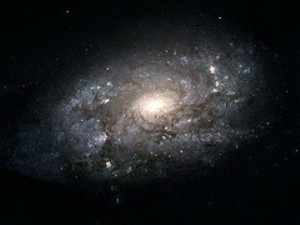A Penn State engineer presumes that exobots , which are autonomous, self-replicating robots can effectively carry out exploring the universe, discovering extraterrestrial life and removing space debris. This is the 50th year for the Search of extraterrestrial intelligence (SETI).
 NGC 3949 lies about 50 million light-years from Earth. It is a member of a loose cluster of some six or seven dozens of galaxies located in the direction of the Big Dipper, in the constellation Ursa Major (the Great Bear)
NGC 3949 lies about 50 million light-years from Earth. It is a member of a loose cluster of some six or seven dozens of galaxies located in the direction of the Big Dipper, in the constellation Ursa Major (the Great Bear)
Electrical engineering professor, John D. Mathews states that human exploration outside low Earth orbit is associated with conservation of resources, economic, political and technical difficulties. Human space exploration therefore entails cost- effective, autonomous and highly efficient solutions.
Development of self-replicating robotic spacecraft will therefore serve the need. Effective space exploration can be achieved when these exobots are deployed along with the incumbent communications systems. Explorations include asteroid belt, Kuiper Belt, Oort Cloud, and more.
Vast resources are required to explore into the galaxy. In addition, emission of radio signals across the sky and energy for space broadcast is also needed.
The IR signaling-based point-to-point communications though require less power, have extremely sensitive directional signals. Due to its tight targeting capability, lasers in laser-driven IR signaling remain insignificant to the extra-terrestrial beings.
By using the resources on the moon and its one-sixth gravity, initially robots can be created there. Compact power source is needed for fabrication. With location detection capability and time determination, the vehicles can enable creation of an autonomous robot network and its target with an IR laser beam containing data.
The initial applications of exobots are cleaning-up of debris and monitoring over 1,200 near-Earth hazardous asteroids.
With a number of resources, the network of self-replicating, autonomous exobots will extend across the solar system and into the galaxy, where they will continue to carry out their mission. Infrared lasers communication is associated with communicating at the speed of light.